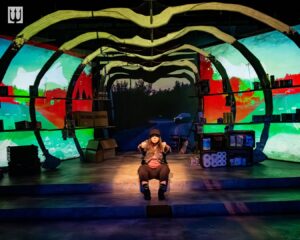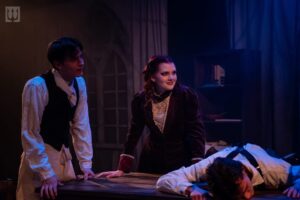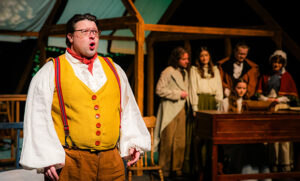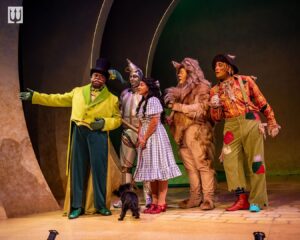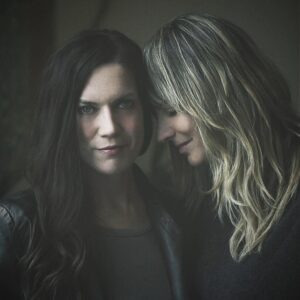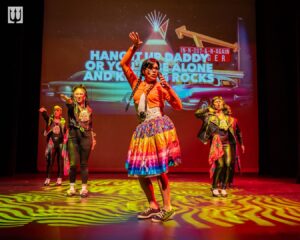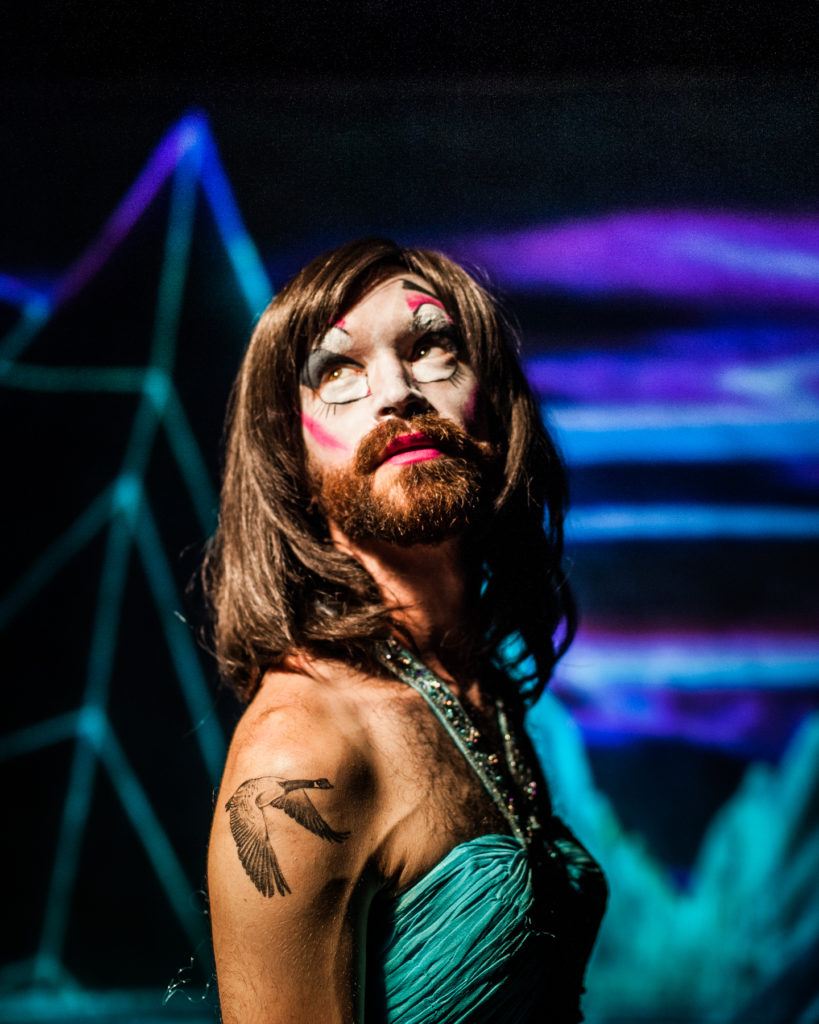
Halifax-based multidisciplinary artists Aaron Collier and Richie Wilcox of the live art company Heist recently remounted The Princess Show, which was awarded Best of Fest at the Halifax Fringe in 2016, and received five Robert Merritt Award nominations, at The Secret Room inside The Local on Gottingen Street. The venue proved ideal for this show, a fun and intelligent mixture of drag show, lip synch, theatre, performance art, music concert, and dance party. Heist is taking their show to The Metro Studio Theatre as part of OUTstages Festival, presented by Intrepid Theatre in Victoria, British Columbia on February 9th, and then they travel to Toronto, Ontario to Buddies in Bad Times for two shows at the Rhubarb Festival on February 22nd and 23rd. Last Friday Collier, Wilcox and I met up (each wearing a variation on the same toque) to chat about the evolution of their theatre company, The Princess Show,and how excited they are to be bringing this show to two Queer Theatre Festivals this month.
Heist is a “takeover” of Angels and Heroes Theatre Company, which Wilcox started when he was just out of University. He is the Artistic Director, Collier is the Technical Director, and Sylvia Bell is the Managing Directing. The company describes itself as a “Queerly playful” live art company, as their productions don’t always fit neatly into the “theatre” box.
The Princess Show was born out of a Queer Club that Collier and Wilcox were running in Lethbridge, Alberta with their friends at Theatre Outre. “The first iteration of it was Bordello,” says Wilcox, “I think that’s where this started.” “We were throwing a sort of Drag Cabaret Night on Valentine’s Day called Love Stinks,” says Collier, “it was basically our first event in Lethbridge. This wasn’t even a gay club at this point, we wanted to find a space to rent to do a play that our partner, Jay Whitehead, had written-“ “Unsex’d,” Wilcox interjects. Collier continues, “So Jay and Richie found this space- it used to be an Irish pub- it was in a building where there was a bar, like a live music bar, a pretty cool spot, then there was an Art Gallery on the second floor, which was also cool, and then there was us running this little performance space. We thought, ‘well we have to pay for it for three months’ (that was the minimum we could rent it for). So we thought, ‘Well, what do you want to do?’
“Let’s do a Cabaret!” adds Wilcox.
“There was a little hutch in the corner,” continues Collier, “and I was planning on coming to the Cabaret in some sort of gender fuckery- just sort of femme in a suit, that sort of thing-“
“Sort of like Annie Lennox,” adds Wilcox.
Collier nods, “That was the inspiration, actually. And so I had this little island, a corner hutch, where I set up my sound table and Jay Whitehead called it ‘Prince Edward Island’, and then he decided that I was Princess Edward, and that was Prince Edward Island, and I’m from there, so it was just wonderful. So from there, [the character] grew a little bit by little bit. We did more Cabarets and eventually Princess was performing in the Cabarets.”
Wilcox’s character, Abel, was also in a way the brainchild of Jay Whitehead.
Wilcox recalls, “We were doing Strip Spelling Bee at the Club, and I decided to dress up as this nerdy [character]. At that point, Abel was very non-binary. I didn’t have a moustache. I had a baby face, and I’m not normally clean shaven, but I did it specifically for that night. I still wear the same wig [in the show]-“ Collier adds, “The wig was a hit right away.” “And I had on the same outfit [he wears in the show]: shorts and suspenders, and this sort of green shirt that’s not pretty, and so I looked nerdy and gender nonconforming. Didi named me as well. I was like, “I don’t know who I am.’ And Didi was like, ‘Abel T. Suckizone.’ And I was like, ‘Amazing. You are so good at this.’” Collier agrees, “Didi/Jay are brilliant.”
“I was Didi’s assistant for the night,” continues Wilcox, “and I helped host Strip Spelling Bee, and I was very nerdy. Then Abel became somewhat of a staple.” “Princess would have been on that show too,” adds Collier, “Princess would have been running the sound. As she does.” “Right!” says Wilcox, “Over time it became clear that Abel was more so a male because then I just started not dealing with my facial hair. Not that that definitely defines what gender you are… but it started to become clear in the plot… although we don’t ever really talk about gender in Princess World. It’s just not important.”
The evolution of Princess as a performer began to emerge throughout various Cabarets at the club. “So, for the Christmas Cabaret Princess would do a piece,” Wilcox explains, “and then we always had this annual festival, Theatre Outre still does this, called Pretty, Witty and Gay, with a big Cabaret as a part of it, and so Princess would do a piece there. So [Aaron] had a handful of performance pieces that [he] had done as Princess Edward.” “They were all generally kind of strange,” recalls Collier, “Some of them involved two minute interludes of a repeating gesture with a high pitched sound happening. It was super campy still. I knew that it was ridiculous. The idea of Princess Edward being a Performance Artist was growing, and about three years later we knew we were leaving Lethbridge shortly and I knew I wanted to do a show. I wanted to do the Princess Edward Show. The Princess Show. So, at a meeting for our club we picked a date in April, this was in February, and we said, ‘Okay. I’ll do The Princess Show on Friday and Saturday night that weekend.’ And then I proceeded to procrastinate until two weeks before the show. And two weeks before the show, me and Richie and Deonie (Hudson) got together, and I’m a sound designer, so I have a little recording studio, so I went and I sat down and I just started to dream of what the show might look like. I ordered a video projector and a scrim because I added up the ticket prices and I saw that I could basically kind of pay for these things… I hoped. I started to design video backgrounds and I started to make video recordings. I sort of made the story up on the spot, speaking into a microphone, and I would be like, ‘Richie, I have this idea that we have a fight.’ And then I had to come up with a character for The Beast, and I was going to build a puppet out of a pizza box- it would have been horrible- and that’s when [Deonie] was like, ‘What about claymation?’ I was like, ‘That’s impossible’ and she was like, ‘No, I can do it.’ So, she downloaded an app, she talked with some friends who had done it before, she got some modelling clay, and then she took hundreds and hundreds of photos and gave me these little animation sequences.”
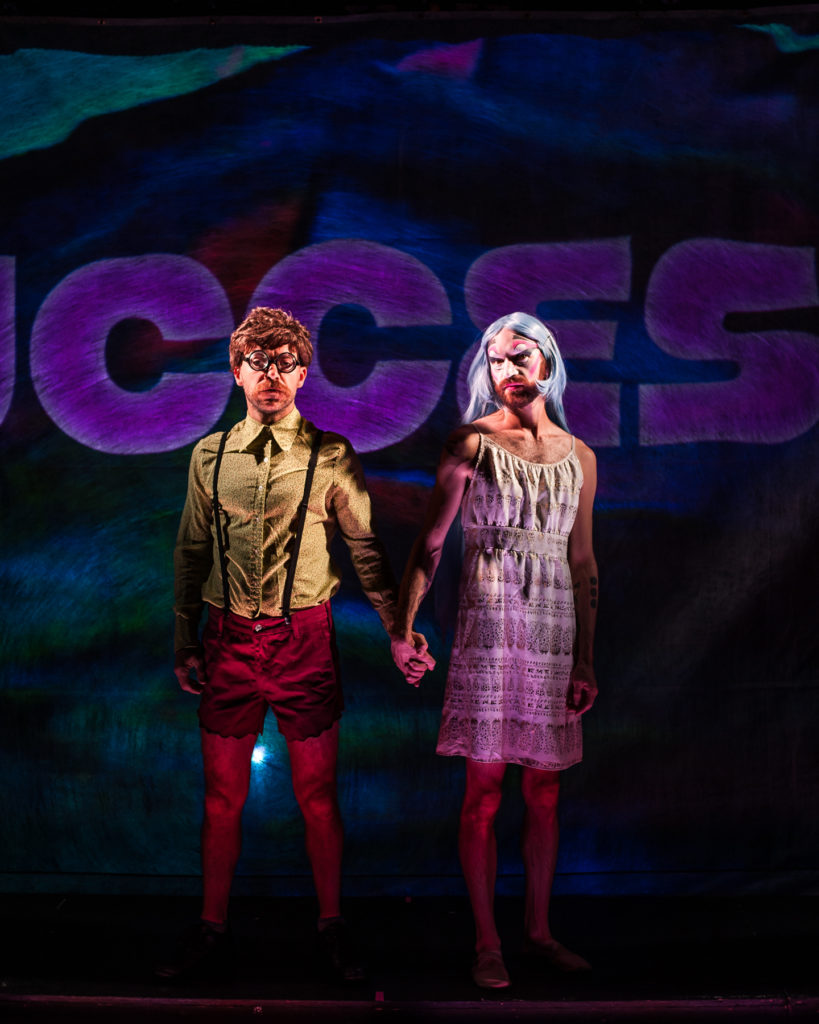
The show came together through a series of collaborations, and also reflects some of Wilcox and Collier’s interests from that time. Wilcox explains, “There were points where we thought, ‘oh we need, [characters] Didi and Ryda [Jay Whitehead and John DeStigter) to show up for a phone call, so we filmed those. We were watching a lot of anime that year, and we knew that this show was our take on trying to put anime live on stage, so our friend Matt Miller did the anime drawings of Princess Edward and Abel and the story elements to incorporate into the protections. Mino [Inoue], a friend we had met who was helping teach at the University…” “She had come from Japan,” Collier adds, “we had met her through some other friends and I was like, ‘I wonder if Mino would do narration, such as in anime, and she said yes. In fact, some of the choreography from the show was taken from Mino because when she recorded her voiceover in the studio she would visualize what was happening, because English was her second language, so we would have huge conversations about what the narration meant… what the gist of what the sentences meant, and then for her to sort of remember them she would have these gestures. She would talk about ‘generations’ and she would do these movements and we filmed a few of them and I was like, ‘I think I should use these as choreography.’” Wilcox adds, “It was great. And she’s really proud of the show. She’s seen it and loved it and she gets excited when she sees it’s going on tour again. Then we did this whole video sequence where we puppeted a flower and a student of mine at the time, Michael McNeil, had a really great camera, and he was like, ‘Yeah I’d love to help out.’ So, just for a day he came and did some filming with us and puppeteered that flower with me. It was a real collaborative effort because the club had made a real close knit community. The club had black drapes everywhere so we did a lot of filming in there, but it also had this huge green wall, which worked really well as a green screen. So, that’s where we filmed Didi and Ryda’s scenes.” Collier continues, “So then we did [the show] in Lethbridge in April. We did two nights of it and people didn’t know what to expect and we were like ‘Here Goes Something.’ “They were pretty astounded,” recalls Wilcox. “We just kept saying yes to things,” explains Collier, “Claymation. Ideas for plot points… because of the fast deadline we just kept really good focus and positive energy to sustain us through those two weeks.”The community already had an attachment to Princess, and they knew we were leaving [Lethbridge] at that point, that we were going back to Halifax, so there was a lot of love in the room. So, that was great,” says Wilcox. “I think that sort of helped define what that show should feel like,” says Collier and Wilcox agrees, “Yes. It did. But then taking it out of that bubble, we then brought it to the Fringe in Halifax, which was super successful. We were awarded the Best of the Fringe that year, and the audiences were really great. That was our return to Halifax, so it was a really nice way to be welcomed back.”
Since then the show has been developed a bit further, adding a few new numbers, a new scene, and tweaking some of the dialogue to fill in some plot holes. They took the show to the rEvolver Festival in Vancouver and then back to the Club in Lethbridge. “We wanted to add live drag numbers from Didi and Ryda at that point,” says Collier, “It was so awesome to have them in the show. They’re sort of integrated into the plot, but we realized it sort of made the show more fun [having them perform in person], it made it more like a party, and more like a drag show. So, instead of being mostly play and a little bit of drag, it started to even it out. We knew when we came back here we wanted to do it again like that.” Wilcox agrees, “That performance in Lethbridge with Didi and Ryda was perfect. So this time around [we’re] doing [the show] with guest performers.” Wilcox says this is gives Heist the opportunity to both work with performers whose work excites them, and also to meet new drag performers and get a better sense of the Queer scene in different Canadian cities. “In Victoria we have Persi Flage, a Drag King who does very theatrical numbers. Their costumes are always a bit heightened, they have a monstery feel to them.” “In Toronto we have Boiband the Boy Band,” adds Wilcox, “so three Kings, [which is] really cool. They’re known for doing Latin numbers. I know one of them, Monica Garrido, and she is awesome. And Manny Dingo is going to be in Toronto too-“ “We do two shows,” adds Collier excitedly, “so we’ll do one show with the Boyband and one with Manny!” Adds Wilcox, “That’s the newest development. We are pretty stoked about it.” “We are still interested in taking [the show] further into the party feel,” adds Collier, “[Our most recent show in] Halifax [at The Local] was another eye-opener where we learned what is happening when the audience arrives is really key to how they can learn about how to enjoy the show.” “And how to interact with it,” says Wilcox. “With good music playing. With people standing around talking,” adds Collier. “With us mingling,” says Wilcox. “That’s a very different feeling than walking in, sitting down and reading,” says Collier, “Very different. It sets you up for a different experience. And we want the uninhibited experience from our audience.”
I ask Collier and Wilcox about what the experience is like for them as actors having all their dialogue prerecorded.
“It creates a unique experience on stage,” says Collier, “In one of those early Cabaret pieces I did as Princess Edward I was like, ‘I want to do a whole scene and I want to lip synch the whole thing.’ I pre-recorded a bunch of dialogue, and then I lip synched it during the performance. Now that I think about it, it was sort of a proof of concept. I don’t know if I realized it at the time. It was a scene between me and a mannequin. When we did The Princess Show, and we were like, ‘Let’s do the whole show lip synched’ I can tell you those [first] two performances were a little bit frightening.” “You have to memorize breath and stutter and sighs,” adds Wilcox. “And the time it takes between lines, and how long thoughts take,” adds Collier. “And then you’re trying to match up your body and gestures to that rhythm,” says Wilcox, “So, it takes a lot of listening, and re-listening, and working it into your body in a very different way than if you were speaking it. … Lip synching is such a Queer thing. It’s in queer culture. We’re not the first people doing stuff like this. When we went to Dublin for the Dublin Gay Theatre Festival at one point we went and saw a famous Dublin Queen, Panti Bliss, and she was amazing, and they were doing this lip synch to a soap opera, an Irish soap opera, between songs. It was ah.may.zing. I feel like that was a bit of an inspiration.” “Oh for sure,” adds Collier, “I loved it. I even was inspired by the way, because they were Soap Operas downloaded from YouTube, the sound of the voice was so close and a little bit low-fi, and we actually recorded all the dialogue for The Princess Show on a microphone from a karaoke machine from, like, 1981. It was the worst microphone but I was like, ‘we’re going to use it’ because I wanted that-“ “Tinny voice,” adds Wilcox, “I love it. I’m really happy to be a part of the culture of lip synch.”
For Collier there is a sense of joy in the knowledge that whether or not he remembers his lines, they will happen regardless. “That’s also part of the show,” says Wilcox, “it’s a one touch and go- so we press space bar and the whole entire 65 minute show goes. You can’t be late for an entrance because your line is going to happen whether you’re on stage or not.” He admits he was terrified the first few times doing a show that is so “beholden to technology” and that he worried about it not working properly, but at this stage of the show’s process he’s trusting it a lot more. “It does come down to, if you’re going to use a lot of technology, you have to be willing to be responsible for lovingly preparing that technology to work for you every time,” says Collier. “The show would fall apart without it,” adds Wilcox. “I think that’s part of our company as well,” adds Collier, “We are conceptual artists but we are also the grunt labour, and, at least for me, I like playing both those roles. Since it was us that actually puppeteered the puppets, and it was it us that filmed the shots, and edited the shots, and did everything, there’s a sense that we’ve touched every little part of it, and that’s helpful in working with technology.” “It becomes organic,” adds Wilcox, “It’s a great showcase of Aaron. It’s a lot of work, but the fact that [he] did the projection design, as well as the sound design, and then performed it, and plays a Fretless bass guitar on stage….he’s a man of many talents.”
I love the idea of Princess Edward and Abel T. Suckizone existing as characters before the plot of their stories were constructed. It reminds me more of the way children invent the worlds of their stuffed animals than the ways we typically think of plays being constructed. Collier agrees, “Our characters were born in a similar step as our stuffed animals in that they are extensions of ourselves. These are self expressions. Princess started out with me wearing lipstick and blush in a suit. But, I liked to dress up in all sorts of clothes as a kid. So, it was just sort of a rekindling of that. I didn’t write Princess. She just came out. There she was.” “People have talked about The Princess Show as a children’s book for adults,” adds Wilcox, “I love that. We’re not inventing new stories here, we are relying on some pretty canonical plot devices; but we are making it our own. These ideas are very much [inspired] by those in video games, in anime, these kinds of stories… so it’s recognizable from our childhoods. Also, while it is fantastical watching [The Princess Show] for some people, it is coming from autobiographical material. The whole entire show. My performance. Aaron’s performance. The script. So, it’s really interesting to revisit it after a couple of years and to be like, ‘Oh, right. That’s THAT spot.’ We allow the self critic to come out of us so much. But, this [show] is just letting the other side come out, which is really vulnerable, which is why it’s important that it was created in a safe space. We credit Theatre Outre as a co-creator of this show because of what happened in Lethbridge, and the space that was created through Jay and Aaron and I and also Deonie and David Gabert, and the community as a whole. It really does help art like this happen.” Collier agrees saying that he felt that Theatre Outre was a place where he was continually being pushed and encouraged as an artist. “In that environment nothing could be Queer enough, nothing could be absurd enough. Nothing could be offensive enough. Nothing could be sweet enough. It just was a very special place. I feel like it informed a lot of our artistic values that we carried into Heist.”
Wilcox and Collier stress that they are so excited and proud to be taking part in two Queer Festivals in Canada this month. “There’s not that many festivals dedicated to Queer work, and having this Queer circuit is really valuable,” says Wilcox, “This is only my second time going to Victoria and OUTstages is only five years old. I’m really happy to be there and to have the opportunity to see other people’s work. I’m excited to see Ivan Coyote’s new show. I’ve experienced Rhubarb a lot because I used to live in Toronto, and I went every year, but to be a part of it, this is my first time as a performer and Heist’s first show in Toronto, so it’s special. I’m really thankful to Mel [Hague, the Festival Director]. It’s something that I had as a goal. It feels really great to bring this one in, especially since it’s Buddies’ 40th Year.” “I’m grateful to know that in the whole landscape of people doing great Queer work [in Canada] there’s more great work than there are festival slots,” adds Collier. “It’s such a privilege to be able to do this work,” Wilcox adds, citing the viral video we’ve all watched that morning of Ellen Page calling out Mike Pence for his homophobia and complicity in the hate crime against Jussie Smollett. “She is REALLY challenging [the politicians] and becoming an activist,” Wilcox says, “Seeing that video today really helps me recognize the privilege of being in Canada at a time when I’m being flown across the country to do, what I think is Queer as Fuck work. We’re really grateful.”
Of course, that’s not to say that Canada is without its own homophobia. Wilcox remembers when they brought Unsex’d to Calgary and the CBC reviewer at the time wrote, “Is there such a thing as gay theatre? I think not.” Which is, obviously, wrong on an infuriating multitude of levels. Collier agrees that their time in Alberta taught them many lessons about dealing with adversity and not taking their privilege for granted. “Living in Lethbridge was the first time I was majorly met with resistance for being Queer and doing Queer work,” says Collier. “It comes down to privilege. I generally have straight-passing cis-white male privilege. One of the most useful things I’ve lived through is just recognizing ‘oh this is what a little bit of adversity feels like.’ It did make me recognize that Queer culture is different.””We’re not here to assimilate,” adds Wilcox. “We’re just here to take up a small amount of space,” adds Collier. “Making space for [Queerness in the Arts] is important and part of the work,” says Wilcox, “Making space for all the people in Queer communities is also a VERY important part of the work. The other thing that is interesting is when you are in a situation where you have this conflict and you’re constantly fighting against something, and yet you come up with a piece that is ultimately very joyful. People leave The Princess Show happy. People talk about that all the time to us, which I think is awesome. There are other queer shows that I can think of that have tackled really difficult things, like Stewart Legere’s Let’s Not Beat Each Other to Death, that, ultimately, are trying to make everyone feel good in the end. Stewart’s piece ends with everyone dancing. We’re dancing ourselves through the grief or the pain. The Princess Show has some heaviness to it too, some personal battles on stage, but ultimately, we are smiling at the end.”
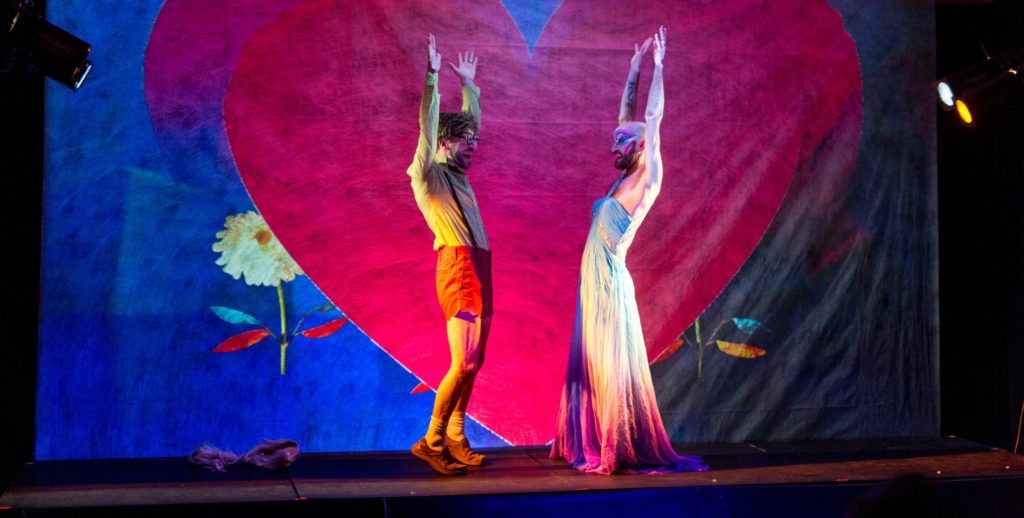
I agree and add that I’m reminded of many of the articles I’ve been reading recently about CBC’s television comedy Schitt’s Creek, created by Dan and Eugene Levy. In it, the creators present the world the way we wish it was was. There is no homophobia in Schitt’s Creek, everybody is accepting of one another. It suggests that by continually dramatizing being Queer as a struggle not only normalizes this perception, but also gives the adversity a sense of power. Conversely, eliminating the struggle, refusing to give homophobia a place in the story at all, sends the strong message that living in a world where being Queer is a non-issue is possible, in fact it looks so easy and sensible. Wilcox, who was also watching Schitt’s Creek the night before, agrees, “It doesn’t have to be an issue play.” Since The Princess Show is set during a futuristic time of tumultuous environmental issues, its world is not at all utopian, but ideas of gender in its world are more universally progressive than in ours. “Princess is Princess and Abel is Abel,” says Wilcox. I suggest that The Princess Show could be described as a sort of Post-Apocalyptic Schitt’s Creek. Wilcox and Collier laugh. “We can write in a role for Dan Levy in The Princess Show Part III,” says Collier. “I think there’s a part for Eugene as well,” adds Wilcox and Collier agrees. Personally, I am very much in favour of this collaboration idea.
As for the future Collier says, “I think we are interested in exploring more forms of Live Art. Things like participatory installations, or, I don’t know, opening up to just like great parties, because we like to throw parties. I think people like to have fun.” Wilcox agrees and mentions their annual Heist Party at Mother’s Pizza. “We take it over,” Wilcox says of the restaurant, “a pure “Heist” where we make the space into a pretty great Queer party. It changes the vibe completely. We do our Cabaret performances there.”
In a city that is desperate for new performance spaces it’s encouraging to see Heist continually finding new and creative ways to bring their work into the community and so heartening to have Collier and Wilcox back in Halifax enriching our theatre scene with their immense multi-talents and generous hearts.
The Princess Show plays TODAY February 9th, 2019 in Victoria, British Columbia at The Metro Studio Theatre (1411 Quadra Street, Victoria, BC) as part of OUTSTAGES FESTIVAL presented by Intrepid Theatre. For TICKETS please CLICK HERE or phone 1-855-842-7575, or visit the Box Office in person at 1050 Meares Street.
The Princess Show plays February 22nd & 23rd in Toronto, Ontario at Buddies in Bad Times Theatre (12 Alexander Street) as part of Rhubarb Festival. For TICKETS please CLICK HERE.
You can follow Heist on Social Media: Facebook. Twitter. Instagram (@LiveHeist)
You can follow Intrepid Theatre on Social Media: Facebook. Twitter. Instagram (@IntrepidTheatre).
You can follow Buddies in Bad Times Theatre on Social Media: Facebook. Twitter. Instagram (@BuddiesTO).
Incoming search terms:
- functionf17

